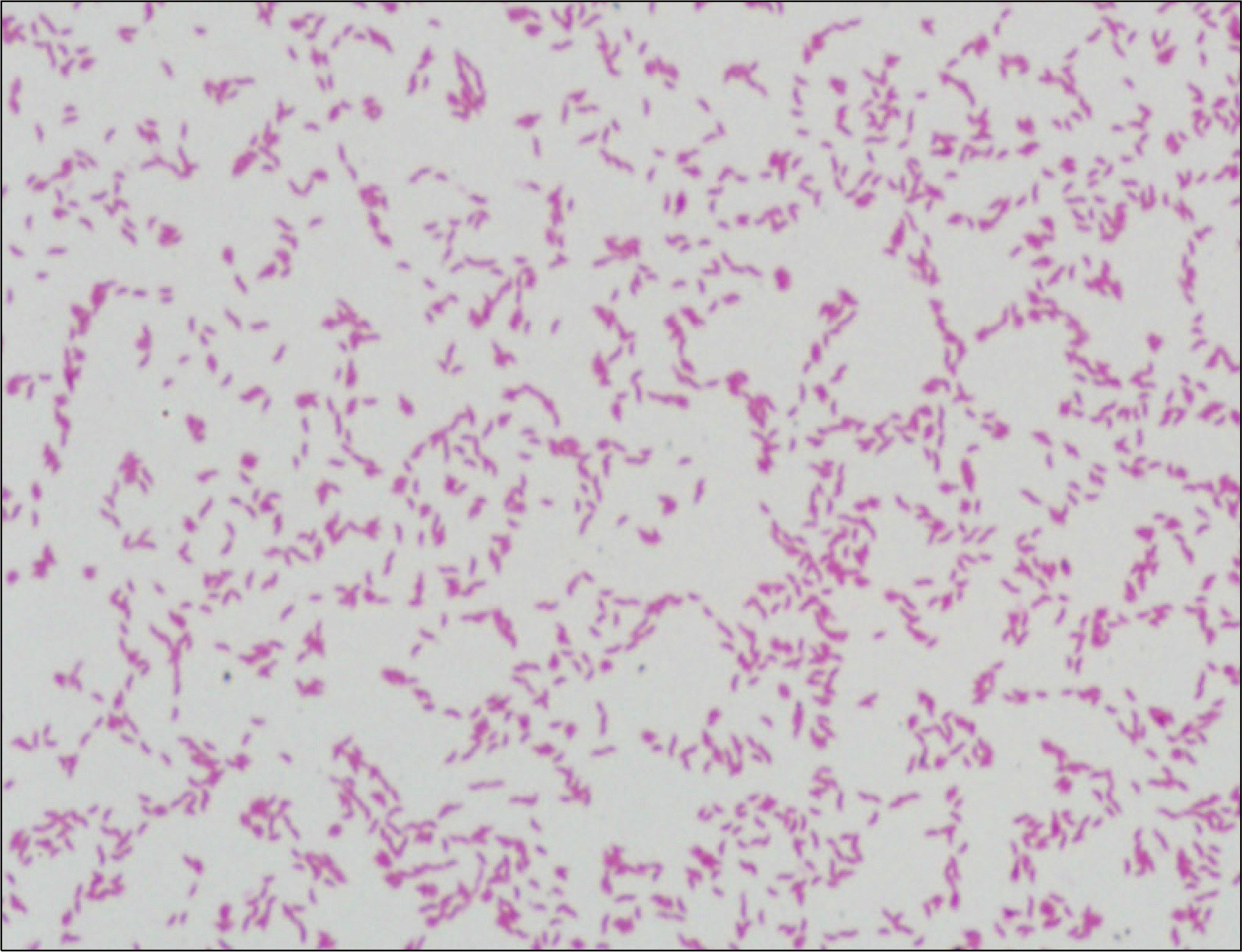Abstract
Campylobacter jejuni is one of the important bacterial pathogens causing entero-invasive diarrhea; however, C. jejuni infection is rarely complicated by bacteremia or extra-intestinal localization. In the domestic literature, the majority of the relevant reports have focused on Campylobacter fetus, which causes bacteremia more frequently than enteritis, but there are no reports of C. jejuni bacteremia in Korea. We present the case of a 13-year-old girl who presented with abdominal pain. Blood cultures revealed curved Gram-negative bacilli and small, mucoid, gray colonies on blood agar plates at 37°C. Biochemical tests showed oxidase-positive colonies. To confirm the species, 16S rRNA sequence analysis was performed. The isolate exhibited 99.7% homology to C. jejuni subsp. jejuni. The patient was treated with third-generation cephalosporin and aminoglycoside and had negative blood cultures after three days of treatment. She fully recovered within four days with no complications.
REFERENCES
1. Fitzgerald C and Nachamkin I. Campylobacter and Arcobacter. Murray PR, Baron EJ, editors. Manual of clinical microbiology. 9th ed.Washington, DC: American Society for Microbiology;2006. p. 933–42.
2. Blaser MJ. Campylobacter jejuni and related species. Mandell GL, Bennett JE, editors. Mandell, Douglas and Bennett's principles and practice of infectious diseases. 7th ed.New York: Churchill Livingstone;2006. p. 2793–9.
3. Pacanowski J, Lalande V, Lacombe K, Boudraa C, Lesprit P, Legrand P, et al. CAMPYL Study Group. Campylobacter bacteremia: clinical features and factors associated with fatal outcome. Clin Infect Dis. 2008; 47:790–6.
4. Fernández-Cruz A, Muñoz P, Mohedano R, Valerio M, Marín M, Alcalá L, et al. Campylobacter bacteremia: clinical characteristics, incidence, and outcome over 23 years. Medicine (Baltimore). 2010; 89:319–30.
5. Kim US, Shin JI, Shin JW, Kim SG, Kim YS, Oh MD, et al. A case of septic pneumonia secondary to community: acquired Campylobacter fetus bacteremia. Korean J Infect Dis. 2002; 34:73–7.
6. Gundogdu O, Bentley SD, Holden MT, Parkhill J, Dorrell N, Wren BW. Re-annotation and re-analysis of the Campylobacter jejuni NCTC11168 genome sequence. BMC Genomics. 2007; 8:162.

7. Nachamkin I. Algorithms for identification of curved and spiral-shaped gram-negative rods. Murray PR, Baron EJ, editors. Manual of clinical microbiology. 9th ed.Washington, DC: American Society for Microbiology;2006. p. 379–83.

8. Uçkay I, Garbino J, Dietrich PY, Ninet B, Rohner P, Jacomo V. Recurrent bacteremia with Helicobacter cinaedi: case report and review of the literature. BMC Infect Dis. 2006; 6:86.

9. Matsumoto T, Goto M, Murakami H, Tanaka T, Nishiyama H, Ono E, et al. Multicenter study to evaluate bloodstream infection by Helicobacter cinaedi in Japan. J Clin Microbiol. 2007; 45:2853–7.
10. Hsueh PR, Teng LJ, Hung CC, Chen YC, Yang PC, Ho SW, et al. Septic shock due to Helicobacter fennelliae in a non-human immunodeficiency virus-infected heterosexual patient. J Clin Microbiol. 1999; 37:2084–6.
11. Skirrow MB, Jones DM, Sutcliffe E, Benjamin J. Campylobacter bacteraemia in England and Wales, 1981-91. Epidemiol Infect. 1993; 110:567–73.

12. Ladrón de Guevara C, Gonzalez J, Peña P. Bacteraemia caused by Campylobacter spp. J Clin Pathol. 1994; 47:174–5.
13. Reed RP, Friedland IR, Wegerhoff FO, Khoosal M. Campylobacter bacteremia in children. Pediatr Infect Dis J. 1996; 15:345–8.

14. Borda N, Gambandé T, Notario R. Two cases of enteritis with bacteremia due to Campylobacter jejuni. Medicina (B Aires). 2006; 66:450–2.
15. Smally AJ, Pool SK, Reza M. Transient Campylobacter bacteremia in a healthy child. South Med J. 1996; 89:1123–4.

16. Kaneko M, Watanabe J, Ueno E, Nakano N. Campylobacter jejuni bacteremia in an immunocompetent Japanese child. Pediatr Int. 2000; 42:579–81.

17. Korea Center for Disease Control & Prevention. The prevalence and characteristics of bacteria causing acute diarrhea in Korea. 2008. http://www.cdc.go.kr/contents/information/had/b/9918_view.html. [Online] (last visited on 21 March 2011).
Fig. 1.
Microscopic findings of Campylobacter jejuni isolated from the blood culture showing slightly curved gram-negative bacilli (Gram stain, ×1,000).

Table 1.
Phenotypic characteristics of Campylobacter jejuni isolated from the patient
| Test | Result | |
|---|---|---|
| Biochemical tests | Oxidase | Positive |
| Catalase | Positive | |
| Urease | Negative | |
| Hippurate hydrolysis | Positive | |
| H2S on TSI∗ | Negative | |
| Antibiotic susceptibility | Nalidixic acid (30μg) | Susceptible |
| Growth temperature | Cephalothin (30μg) 25°C 36°C | Resistant No growth Growth |
| 42°C | Growth | |
| Growth in MacConkey | Growth |




 PDF
PDF ePub
ePub Citation
Citation Print
Print


 XML Download
XML Download